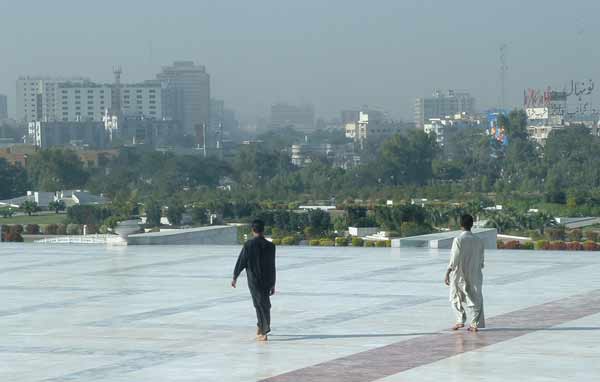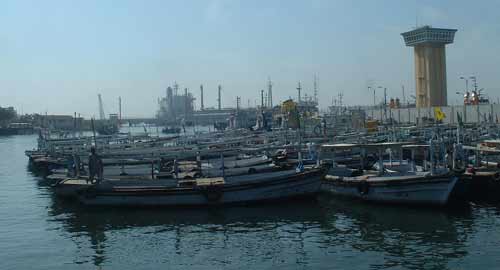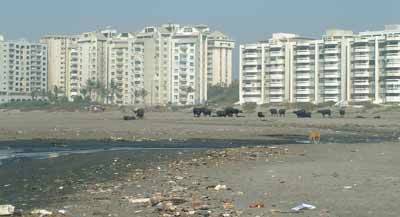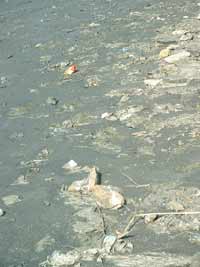SWEDISH SOUTH ASIAN STUDIES NETWORK
Reflections from a sightseeing tour in Karachi, Pakistan:
 On
24 February 2003, Sunday morning, we went for a quick sightseeing
tour of Karachi, before proceeding by an afternoon flight to the federal
capital of Islamabad. Our Karachi taxi driver was given two hours to show
us Saddar, the old town, other interesting places and also the
Clifton beach.
On
24 February 2003, Sunday morning, we went for a quick sightseeing
tour of Karachi, before proceeding by an afternoon flight to the federal
capital of Islamabad. Our Karachi taxi driver was given two hours to show
us Saddar, the old town, other interesting places and also the
Clifton beach.
We drove through almost deserted streets surrounded by giant advertisement
boards displaying the latest gadgets in mobile phones, fashion clothes
… whereas below on the streets lay an incredible amount of garbage,
plastic bags, and litters of all kinds. Beggars approached us at every
crossing… poverty is on the increase in Pakistan and this giant
15 million city has a lot of it, side by side with all the wealth and
luxury.
Central Karachi is an old town with colonial buildings and lively market
places, The Salvation Army is situated here, well entrenched behind high
walls.
 This was once a small port city founded by the British as late as 1839
– and the port is still very important for the Karachi economy (photo
from the harbour to the right). At the time of the foundation of
Pakistan in 1947, it had only 300 000 inhabitants. It was made the capital
of the new country and it was here that most of the mohajirs, the urdu-speaking
Muslim refugees coming from Uttar Pradesh, Bombay and other places in
India ended up.
This was once a small port city founded by the British as late as 1839
– and the port is still very important for the Karachi economy (photo
from the harbour to the right). At the time of the foundation of
Pakistan in 1947, it had only 300 000 inhabitants. It was made the capital
of the new country and it was here that most of the mohajirs, the urdu-speaking
Muslim refugees coming from Uttar Pradesh, Bombay and other places in
India ended up.
It was also here that the new industries grew up, and it did not take long before it became a World metropolis with plane-loads of businessmen and politicians arriving in a thick stream, with a bustling nightlife where people from all corners mixed. Till 1984 the Scaninavian Airlines, SAS, had a direct flight Copenhagen–Karachi (and onwards to Calcutta). Not much of that époque is visible any more. After the changes the Zia ul Haq regime brought to Pakistan Karachi has turned into an increasingly Islamic modernity, with few women visible in public life, with no alcohol, bars and night clubs…
We left the old town and came out in open space and the
seat of the Jinnah Mausoleum, a Pakistani variant of Taj Mahal, imposing
in majesty, surrounded by a very big garden with space for planned additional
buildings, a museum, etc.
We then headed for the biggest market in town, the Tariq market, but when
we came there is was stone dead. Naturally, on a Sunday morning in the
holy month of Ramadan.

 From
there we drove southwards, passed Benazir Bhutto’s fortified residence
and reached the Clifton beach. We immediately felt the smell of oil in
the air, and it also lay in thick layers in the water and on the beach.
Through the haze of polluted air we could see the back portion of the
shipwrecked oil tanker Tasman Spirit at a distance.
From
there we drove southwards, passed Benazir Bhutto’s fortified residence
and reached the Clifton beach. We immediately felt the smell of oil in
the air, and it also lay in thick layers in the water and on the beach.
Through the haze of polluted air we could see the back portion of the
shipwrecked oil tanker Tasman Spirit at a distance.
This felt like doomsday; the sand all along was not sand but a greyish
silvery powder which came into the shoes … and stuck.
A lonely camel approached us and its owner offered us a tour or a least
a sit up for a photograph. We didn’t oblige.
The oil tanker broke down here more than six months earlier, but so far no real action had been taken by the municipality, the provincial government of Sindh or the central government. This is now seen as one of the notorious shortcomings accruing to the bureaucracies. It is a bewildering experience. Just on the seashore at Clifton new luxurious flats have been built supposedly inhabited by the upper classes. Have they no stake in cleaning up the shore? How can they just turn their back to what’s is so nearby?
SASNET - Swedish South Asian Studies Network/Lund
University
Address: Scheelevägen 15 D, SE-223 70 Lund, Sweden
Phone: +46 46 222 73 40
Webmaster: Lars Eklund
Last updated
2006-01-27
